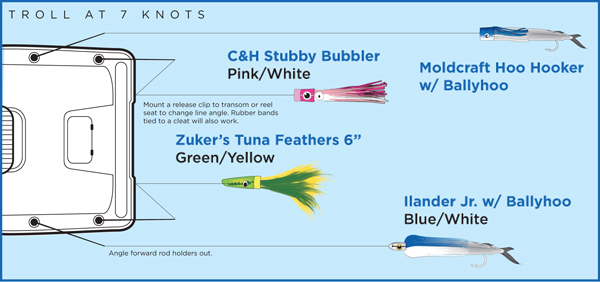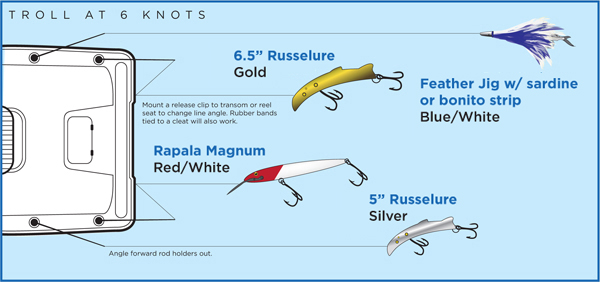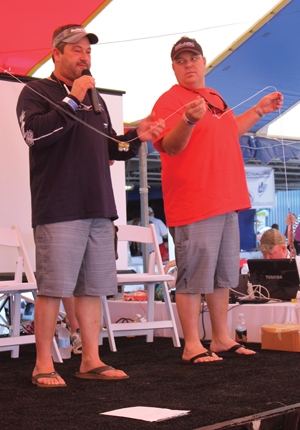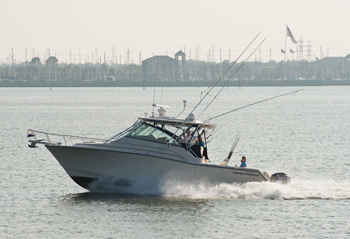
Lone Star Shootout champions, Team REHAB with a 412.5 pound blue marlin.
VIEW THE 2015 LONE STAR SHOOTOUT RESULTS HERE
By Dawn Messina
The Lone Star Shootout, formally The Houston Invitational Billfish Tournament, started in Galveston in 2005 as a function of The Houston Big Game Fishing Club. It was moved to Freeport in 2007 and six years ago, again moved to Port O’Connor a location that has proven to successfully attract bigger participation. The Lone Star Shootout provides serious funds for the Houston Big Game Fishing Club’s charitable programs, supporting college scholarships and other programs relating to fishing, boat safety and Warrior’s Weekend.
To date HBGFC, due in large part to the funds raised at the Shootout and with the support of its members and corporate sponsors, has funded over $150,000 in scholarship money.
The tournament was held July 22-27, following the week of Poco Bueno at Port O’Connor’s Caracol Coastal Development. Most of the boats that fished Poco also participated in the Lone Star Shootout. However, captains and crew members may change, fishing a different boat from the previous tourney.
The tournament concludes with an awards party, remembered and talked about each and every year for great food, entertainment and fellowship. Prizes are awarded for billfish, wahoo, tuna and dolphin. The Perpetual Champion’s Trophy is the prized possession of each year’s champion and has become one of the most sought after trophies on the Gulf Coast tournament trail.
I found the Lone Star Shootout to be the most fun to attend. It’s smaller than Poco Bueno, but still offers the opportunity to compete against some of the best billfish teams in the U.S. and a chance to win big money. The Shootout has one of the largest payouts of any tournament in the western Gulf with a billfish release format.
The action started off hot on day one and kept going to the last minute of fishing with no less than ten boats reporting at least two marlin releases. After all the boats were in, videos reviewed and paperwork confirmed, the field had caught a record total of 98 billfish! The totals were 35 blue marlin, 30 white marlin and 33 sailfish.
The Lone Star Shootout had 52 participating boats this year, offering optional side pot betting instead of a Calcutta. These side pots pay out 95 percent of the total amount entered and the remaining 5 percent of the total will is donated to HBGFC Charitable and Scholarship Funds. Optional side pots include billfish release pots in the amounts of $5,000, $2,500, $1,000, and $500, daily pots of $500; gamefish pots, including weighed blue marlin pots of $3,000, $2,000, $1,000 and $500; a winner-take-all pot of $2,500 for total tournament points and a crew side pot in the amount of $400. This year’s total was a whopping $965,900! The Houston Big Game Fishing Club received $48,295 for their charitable fund.
The tournament also featured a $1 million reward for a state record blue marlin! To qualify for this reward, the fish must be certified by the State of Texas and caught according to all tournament rules and any other rules as specified in the $1 million reward rules published and provided to participants prior to the fishing days. Wow! Now we’re talking!
The point system employed during the tourney awards any released blue marlin 750 points for both the release side pots and for total score. Weighed blue marlin will count one point per pound for weighed blue marlin side pots and 750 points each for the total points scored. Released white marlin score 200 points and sailfish 100 points. Scoring for the overall tournament points will consist of total billfish release points, plus 750 points for each weighed blue marlin meeting the tournament minimum length of 102 inches.

The Shootout was well attended this year.
There was one aspect of the event I found interesting, that I never really understood until a good friend, Mark Phillips explained it. There is the “meat pot” and the “biggest fish pot,” meaning a boat can come in with the biggest fish and not win the big money depending on which side pot they bought into! They win a beautiful trophy and bragging rights but not necessarily money. Betting on the “meat pot” is very expensive but provides opportunity for a nice payout. So it’s kind of, “put your money where your mouth is” so to speak! It can be $40,000 and up depending on across-the-board betting for one boat and all species of tournament fish caught during the tournament.
Congratulations to the Lone Star Shootout Champion team REHAB, who scored 2,450 points with two blue marlin releases, two sailfish releases and weighed a 412.5-pound blue marlin on day one of fishing. REHAB is owned by Jasen Gast and captained by Troy Day.







 Bastante Founder Tami Noling
Bastante Founder Tami Noling







 Proven dorado colors are blue/white, pink/white and green/yellow. Change your spread to the colors they are hitting the hardest. Feather jigs,
Proven dorado colors are blue/white, pink/white and green/yellow. Change your spread to the colors they are hitting the hardest. Feather jigs, 
 Kingfish are abundant in the Gulf and will strike baits with unbridled aggression and speed. Gold and silver
Kingfish are abundant in the Gulf and will strike baits with unbridled aggression and speed. Gold and silver 











 By Capt. Joe Kent
By Capt. Joe Kent When you say Striker Mega or Luxury Yachts to well seasoned mariners, they will tell you unequivocally they are the best designed and durable yachts ever built.
When you say Striker Mega or Luxury Yachts to well seasoned mariners, they will tell you unequivocally they are the best designed and durable yachts ever built. Combined with the highest quality craftsmanship and Alcoa’s new much stronger NAUTIC-AL aluminum plated hulls, Striker Yachts do not require zincs and are impervious to galvanic corrosion. The Striker line extends from the finest sport fishing yachts, from 50 feet to over 150 feet, to the world’s largest super yachts up to 1,000 feet (300m).
Combined with the highest quality craftsmanship and Alcoa’s new much stronger NAUTIC-AL aluminum plated hulls, Striker Yachts do not require zincs and are impervious to galvanic corrosion. The Striker line extends from the finest sport fishing yachts, from 50 feet to over 150 feet, to the world’s largest super yachts up to 1,000 feet (300m). With record breaking super yachts becoming even more popular and with the top two being built in the last 24 months, Striker is capable now and well into the future to build the world’s largest super yachts. Building yachts up to 300 meters, which is far beyond any other yacht builder in the world. All yacht builds will be completed at our shipyards, built to the highest levels of ship building for safety and sea worthiness, and incorporated into a fine yacht with the style and comfort brought to us by our award winning naval architects, Donald Starkey, Gregory C. Marshall, and Luiz DeBasto, for truly unique world class yachts.
With record breaking super yachts becoming even more popular and with the top two being built in the last 24 months, Striker is capable now and well into the future to build the world’s largest super yachts. Building yachts up to 300 meters, which is far beyond any other yacht builder in the world. All yacht builds will be completed at our shipyards, built to the highest levels of ship building for safety and sea worthiness, and incorporated into a fine yacht with the style and comfort brought to us by our award winning naval architects, Donald Starkey, Gregory C. Marshall, and Luiz DeBasto, for truly unique world class yachts. Striker Yacht Corporation
Striker Yacht Corporation




 Sword seekers and sponsors came together Saturday, April 26 at Surfside Marina and did something incredible for our United States veterans. The 4th annual “Get Tight Sucka” Texas Swordfish Seminar by the Booby Trap Fishing team raised close to $400,000 for Everyday Heroes, an organization that helps veterans get wheelchairs, scooters and whatever else they may need without any of the red tape.
Sword seekers and sponsors came together Saturday, April 26 at Surfside Marina and did something incredible for our United States veterans. The 4th annual “Get Tight Sucka” Texas Swordfish Seminar by the Booby Trap Fishing team raised close to $400,000 for Everyday Heroes, an organization that helps veterans get wheelchairs, scooters and whatever else they may need without any of the red tape.







 “It’s got triple Yamaha 250 outboards, a couple of bedrooms downstairs, an air conditioned bridge and downstairs area. It’s set up for fishing, but it’s a good all around boat. It holds about 370 gallons of fuel, but it burns a lot, too,” he said.
“It’s got triple Yamaha 250 outboards, a couple of bedrooms downstairs, an air conditioned bridge and downstairs area. It’s set up for fishing, but it’s a good all around boat. It holds about 370 gallons of fuel, but it burns a lot, too,” he said.













